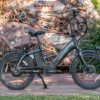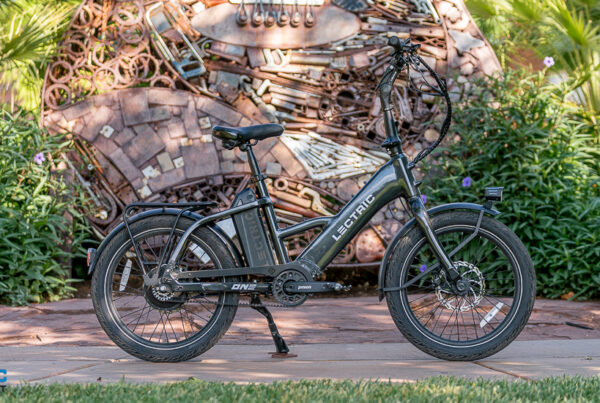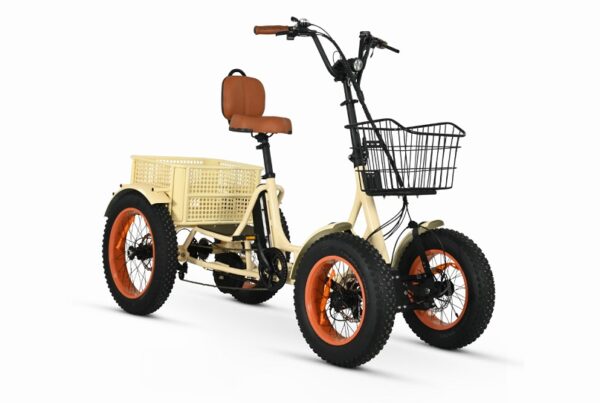Some links may be affiliate links. We may get paid if you buy something or take an action after clicking one of these.

So, what happens when an e-bike maker best known for powerful all-terrain designs decides to make a commuter? In the case of QuietKat, that means building it with a 500W Bafang hub motor and 614Wh battery, spec’ing it with 3-in.-wide tires for comfortable road riding and light offroad riding, a 7-speed Sram drivetrain to conquer hills, plus lights, fenders and a rear rack to give it commuter functionality.
We took the QuietKat Villager on roads, bike paths and even some smoother unpaved roads and trails to see just how versatile this e-bike is for ourselves.
While the QuietKat Villager isn’t meant to be a backwoods explorer delivering sportsmen (and women) to their favorite hunting blind or fishing hole that its stable-mates are, it accommodates a broad number of uses and many of QuietKat’s accessories can be added to give the Villager optimal versatility.
For this review of the QuietKat Villager we subjected the bike to all the same tests as we’ve done for its off-roading siblings.
Bike Category: Fat Tire/Commuter
Bike Class: Class 2: pedal assist/throttle assist up to 20 mph
QuietKat Villager Video Review
 Pro’s
Pro’s- 500W Bafang hub motor has the power for speedy acceleration and climbing
- 100mm-travel suspension fork smooths bumps and rough roads for terrific comfort
- Includes an integrated rear rack, front and rear fenders and a front light to make it commute-ready
- QuietKat offers an unusual array of accessories to make it more than a typical commuter
- The large balloon tires worked rather well and added to the overall comfort
 Con’s
Con’s- Very little assistance in PAS 1 and 2 means PAS 3 is your realistic lowest motor level
- The large 203mm mechanical disc brakes work okay, but we wonder if the bike wouldn’t be better off with 180 mm hydraulics instead
ELECTRICAL SPECS & FEATURES
- Battery: 614Wh, 48V
- Display: LCD
- Motor: 500W Bafang motor
- Headlight: Included
- Taillights: N/A
- Peal Assist: 1-5
- Range: 31-37 mi. Real world EBR test
- Throttle: thumb button
Weight & Dimensions
- Claimed weight: 50 lbs. (frame)
- Maximum rider weight: 325 lbs. for rider and load
- Maximum load on rear rack: Not specified
Components & Accessories
- Brakes: Tektro mechanical disc, 203mm rotors
- Fenders: Included
- Fork: RST coil suspension
- Frame: 6061 aluminum
- Drivetrain: Sram 7-speed
- Grips: rubber, lock-on
- Saddle: Ergonomic
- Handlebar: aluminum
- Kickstand: Included
- Pedals: Alloy
- Tires: Kenda, 26 x 3 in.
QuietKat Villager Review: Bike Overview
The QuietKat Villager means to split the difference between a city commuter and an all-terrain machine. With its broad saddle, wide tires and suspension fork, it is meant to be comfortable. Its 500W direct-drive motor it has the power to cruise at 20 mph, with or without pedaling.
To make it suitable for commuting, QuietKat equipped the Villager with an integrated rear rack, front and rear fenders as well as a headlight. With its 7-speed Sram drivetrain, it has the gears to get over hills and roll some unpaved roads. Tektro mechanical disc brakes make the bike easy to manage even on quick downhills.
As with QuietKat’s other e-bikes we’ve reviewed, the Villager can be equipped with a variety of different accessories for the outdoorsman or the commuter.

The QuietKat Villager brings rugged design to an urban-oriented ride.

The 500W Bafang motor provided solid acceleration.

Integrating the rear rack into the frame, rather than bolting one on made it stronger and more attractive.
QuietKat bills the Villager as a combination urban cruiser and all-terrain bike. Thanks to its big, 3-in.-wide tires, the Villager can handle unpaved roads and even some trails. Practically, that means the Villager rolls best on paved roads.
The 6061 aluminum frame integrates the battery into the downtube, which, combined with the low, step-thru design and 16-in. standover height makes this e-bike especially easy for smaller riders to mount.
QuietKat Villager Review: Motor Performance, Speed and Acceleration

Our circuit we test bikes on is a one-mile loop with four right-hand turns and a 30 foot rise. We ride a lap in each of the different PAS levels as well as an initial one with no assistance. On our opening lap, we averaged 13.3 mph, which isn’t bad – it lets you know this bike rolls well on it’s own sans motor.
With the motor set to PAS 1 we didn’t feel much assistance and it showed with an average speed of just 13.6 mph. PAS 2 also lacked much oomph and only delivered an average speed of 13.9 mph. It was in PAS 3 that we finally felt the e-bike’s promise, and it cruised to an average speed of 14.9 mph – realistically it feels like you’ll have to live in PAS 3 for noticeable help. Once we bumped the assist level up to PAS 4, then we got a very solid response and an average speed of 17.3 mph.
Finally in PAS 5 we saw an average speed of 20.5, only a bit above the maximum permitted for a Class 1 or 2 e-bike. I largely attribute this to the tires rolling well and holding speed as the motor did cutoff around the 20 mph mark. The gearing was mostly adequate to get to these speeds, but since it’s so easy to roll past 20 mph I did find myself wishing for another gear to not soft-pedal so much.
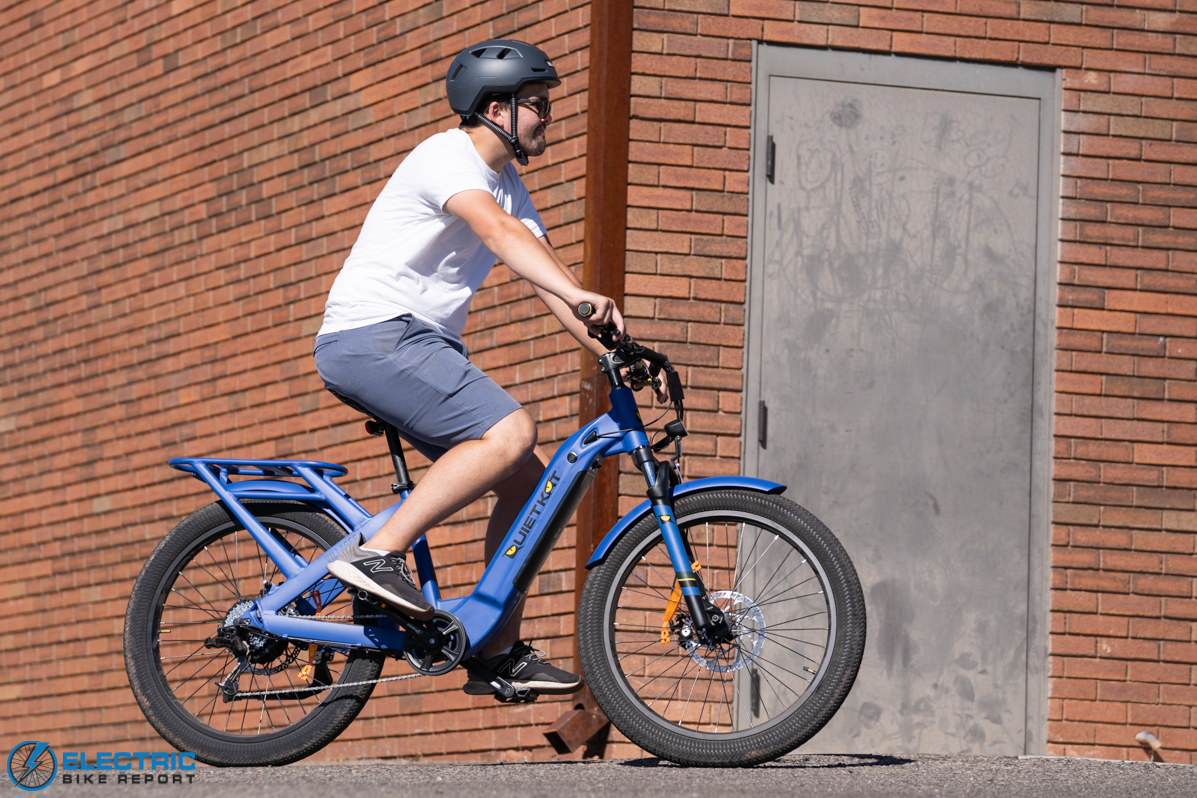
The wide tires offer stable wandering and the take corners well
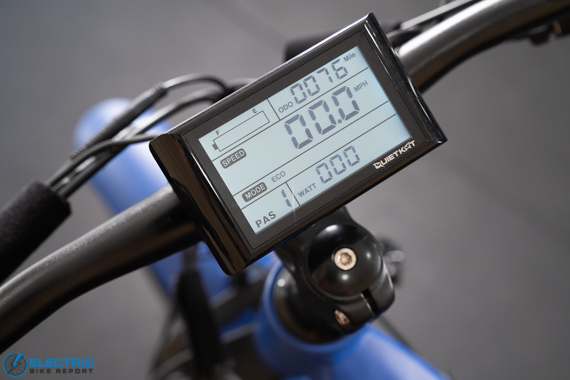
The LCD display isn’t especially large, but shows a number of different data points; we like that it was mounted at the stem, rather than out near the grips.
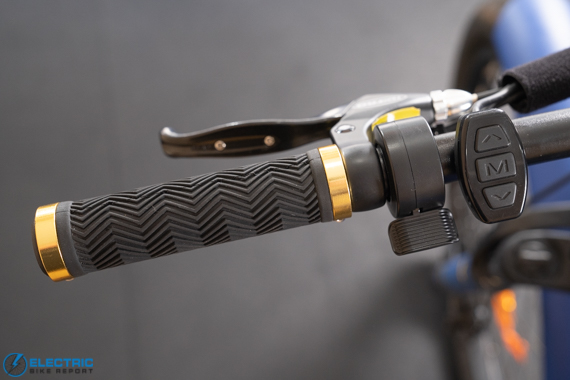
The lock-on grips were comfortable and we loved the gold accents. The throttle was an easy reach, as was the controller.
QuietKat Villager Review: Range Test & Battery Performance
The results from our range test were something of a mixed bag. We sent our tester out on the QuietKat Villager set to PAS 5 and it covered 31 mi., substantially more than what QuietKat listed as its potential range at this PAS level with the website listing 19 miles on the low end. It was an impressive result.
In PAS 3 (which is the realistic lowest PAS for getting reliable assistance), most riders would expect to see a substantially greater range than they did in PAS 5, and while the QuietKat Villager’s range did grow, it didn’t grow by much. Our test rider covered 37 miles. While that isn’t a bad result, we didn’t understand why its range grew by only 6 mi. It’s a surprising result, and while we were a touch disappointed it didn’t give us even more range in PAS 1.
At the end of the day there is enough battery to last you a very long ride, or several shorter ones between charging, and you can dial your preferred speed in across three of the PAS levels, but there isn’t a lot of incentive to take it slow where adding battery life is concerned.
QuietKat Villager Review: Hill Test
The QuietKat Villager features a 500W hub. Hub motors often provide terrific power, but can also struggle to produce sufficient torque for hill climbing on. The QuietKat Villager, however, performed well.
In our run up the ⅓-mile, 12 percent climb of Hell Hole, the QuietKat Villager made the ascent in 72 seconds, at an average speed of 15.1 mph. It’s a fine performance for a 60-lbs+ e-bike with a 500W motor.
Not only does the motor help with hills, but QuietKat even specs the Villager with an above average drivetrain. The Sram 7-speed system makes for crisp and reliable shifting. You’ll be able to adjust on the fly even if the path you’re on goes from flats to hills in a hurry.
The only way in which the gearing isn’t ideal is due to the fact that the motor and tires are such a good combo. The bike can get up to speed and rolls well beyond it. The seven gears are adequate for handling up to 20 mph (the motors class 2 cutoff point), but given that it’s easy for the bike to pick up speed beyond it I did notice quite a bit of ghost pedaling at the cranks in an effort to try and keep up. It’s something I encountered frequently enough to point out, but it didn’t enter the realm of bothersome.

The Villager has a striking presence with this blue paint job and yellow cat eyes
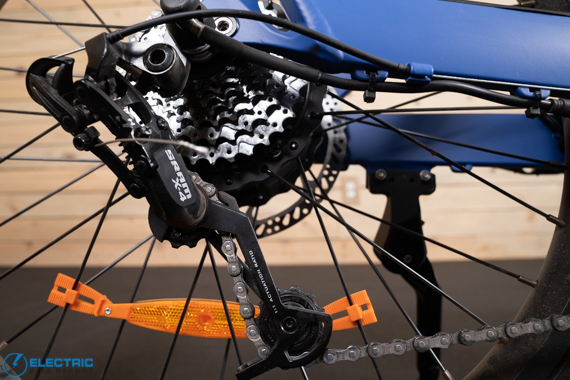
We don’t often see SRAM drivetrains on e-bikes in this price range, but these are good components that will last with minimal maintenance.

The beefy tubing used in the QuietKat Villager’s aluminum frame gave it a very confident ride.
QuietKat Villager Review: Brakes and the Brake Test
We talk about hydraulic disc brakes matched with 180mm rotors being the gold standard for brakes on e-bikes. It’s possible to improve braking beyond that point, by either moving from two-piston calipers to four-piston calipers (two per side), or by swapping the 180mm rotors for 203mm ones. That said, the only riders on bikes with such setups are typically mountain bikers who spend more time in the air than some birds.
When we noticed the QuietKat Villager spec’d with mechanical disc brakes we were curious how they’d do. Mechanical discs typically don’t stop as well as hydraulic ones, but that’s not to say they don’t stop.
In our brake test we performed three passes to make sure we were getting consistent data. As we’ve mentioned in other recent reviews, we’ve altered our test protocol slightly. Previously, we were performing panic stops to find out the absolute shortest stopping distance possible for the e-bikes we test. The problem was, it doesn’t accurately reflect the riding experience of most people. We now do the test remaining seated, braking as hard as we dare, but without skidding.
The QuietKat Villager needed 26 feet 6 inches to come to a stop. It’s an understandable result, considering this e-bike is equipped with mechanical disc brakes. They are capable brakes, but not quite as powerful as hydraulic discs.
It’s a longer distance than most brake tests we’ve performed meaning that in our unofficial scoring department we’d call the Villager’s braking capabilities just ‘okay’. The good news is they help you stop comfortably. That is to say, you remain in control and the wheel doesn’t skid or fishtail on you. But again, given how easy it can be to ramp up speed we’d hope for something with a bit shorter braking distances and we wish hydraulic brakes came on the Villager instead.
QuietKat Villager Review: Ride Comfort, Handling and Cockpit
The QuietKat Villager trades in nothing so much as comfort. Sure, the Villager’s build showcases a beefy aluminum frame meant to be stiff. Shouldn’t that make the e-bike less comfortable? No, because the combination of 3-in.-wide tires, suspension fork and a well-padded saddle do more to cushion the rider from bumps in the road than the aluminum frame’s stiffness can to rattle a rider. What’s more—the stiff aluminum frame makes the bike handle more predictably. The more the frame flexes, the less secure a rider feels.
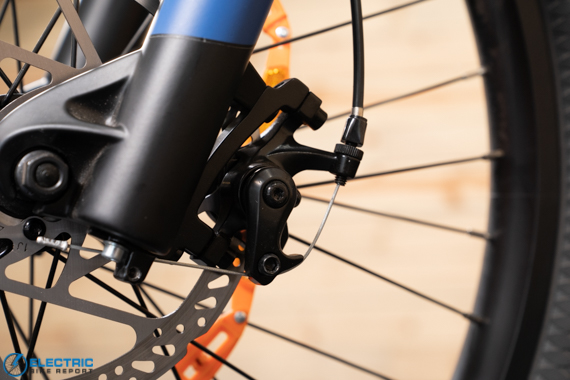
Mechanical disc brakes with 203mm rotors offer okay stopping power while keeping the cost down.

The Kenda tires provided excellent traction on pavement and performed well on hard-packed dirt trails and roads.

The 100mm-travel RST coil-spring fork makes a noticeable difference in the e-bike’s overall comfort.
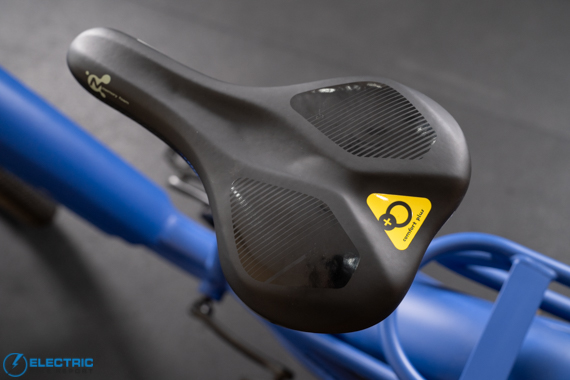
The broad saddle offered terrific support while the central channel cut pressure on sensitive areas.
The QuietKat Villager is meant to enjoy a relaxed riding nature. From its gentle steering to the way the seat is positioned behind the cranks, making it easier for riders to reach their feet to the ground without leaving the saddle, this bike chills rather than thrills when it comes to riding.
QuietKat Villager Review: Summary / Where to Buy
Here’s the bottom line from my time reviewing the QuietKat Vilager: it’s a bike meant for commuting for those looking for something bigger and sturdier. The wide tires roll well and offer great stability. The welded on rear rack is confidence inspiring for the variety of accessories it can be equipped with and the gear you’d look to haul.
It’s cool to see a company so well known for going off-road put together something for urban settings too – it carries the same rough and rugged flair the brand is known for, but sets it loose in a new environment.
It’s got its warts as virtually all products do: I’d swap the 203mm mechanical brakes for 180mm hydraulics, and I wish you could fully utilize all five levels of pedal assistance instead of having only three that are practical so people could better dial in their preferred speed.
But those points aside there is plenty to like about what the Villager brings to the table. There are several attempts to provide you with more than your typical commuter be that from a Sram drivetrain or the 100mm travel of the front fork.
I can see QuietKat fans who want something for city-suited springing for the Villager while leaving their hunting bike at home, or heck, anybody who wants a bigger bike wat larger tires that do well on the road wanting to take the Villager for a spin.
‘Happy Riding, make sure to let us know if you have any questions down in our comments section or if you think we left anything out in this review of the QuietKat Villager.
Reader Interactions
![]()
Source link





